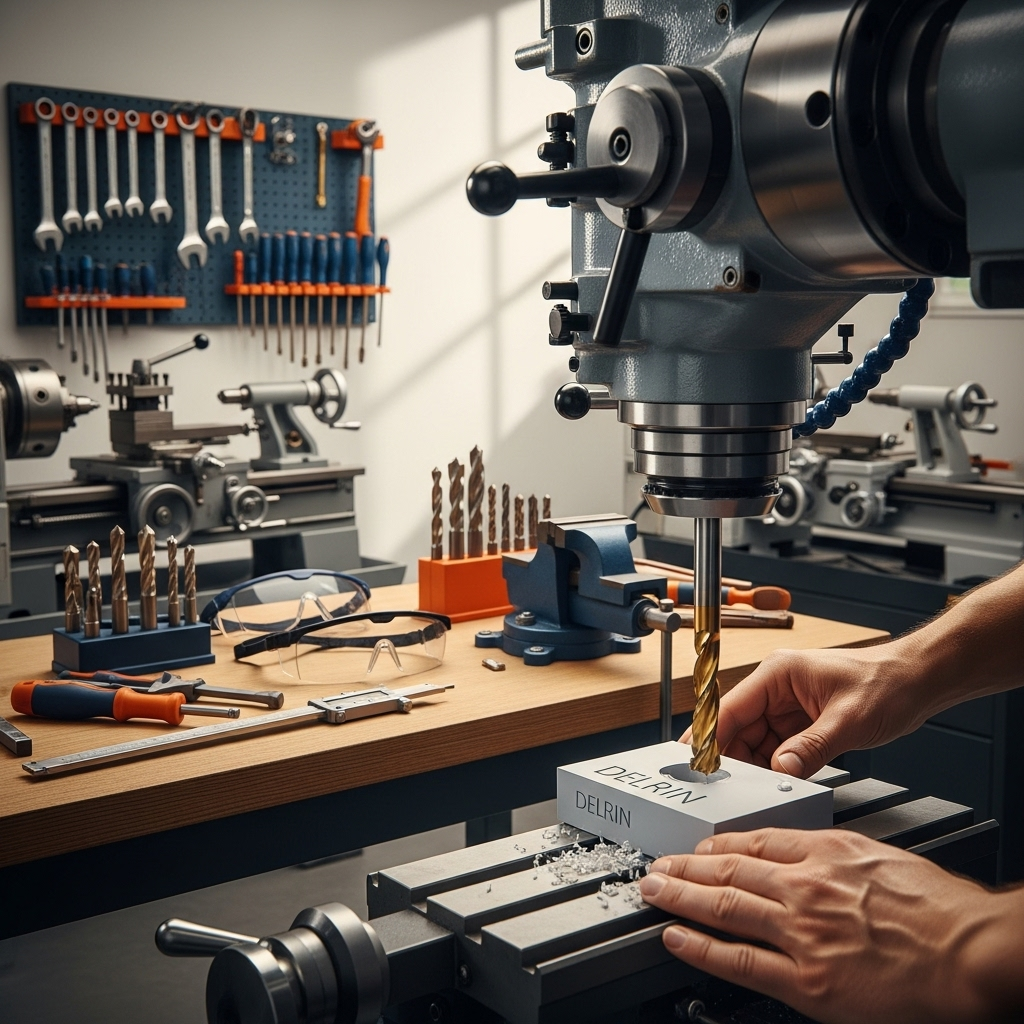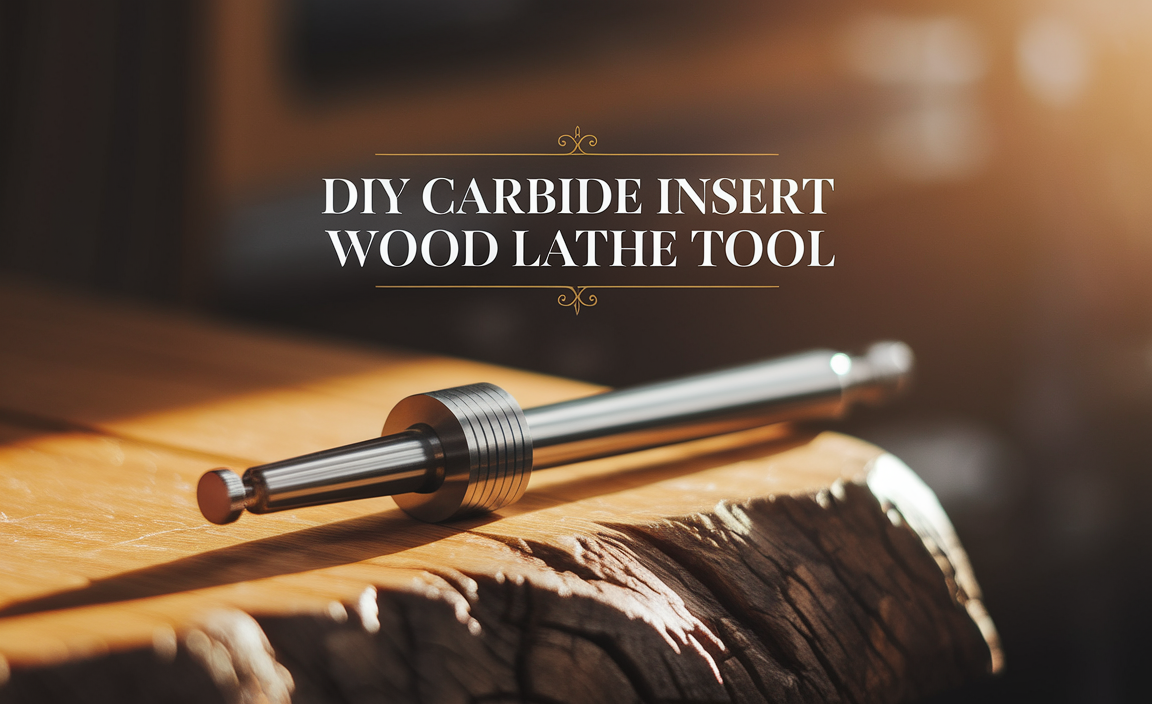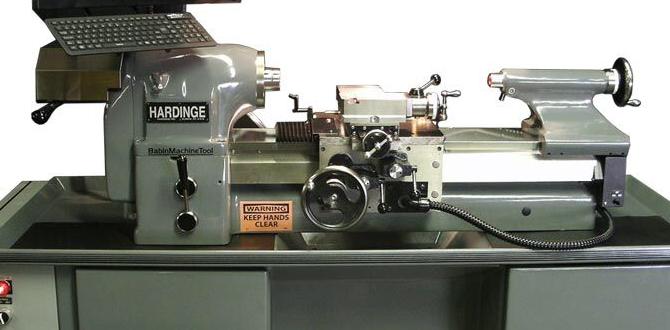Quick Summary: Mastering 3/16 inch ball nose end mill feeds and speeds for Delrin involves finding the sweet spot for chip load and surface speed. Consistent, lighter chip loads at moderate RPMs prevent melting and produce clean cuts, ensuring excellent results for your Delrin projects.
Hey there, fellow makers! Daniel Bates here from Lathe Hub. Ever found yourself staring at a piece of Delrin, holding a neat little 3/16 inch ball nose end mill, and wondering about the magic numbers – the feeds and speeds? It’s a common spot to be in, especially when you’re working with plastics like Delrin. Get these wrong, and you can end up with melted messes instead of beautiful, smooth curves. But don’t worry, that’s exactly why we’re here today. We’re going to demystify the process, making it simple and straightforward, so you can confidently tackle your next project. By the end of this, you’ll know exactly how to set up your machine for success. Let’s get those tools spinning!
Understanding Delrin and Why Feeds & Speeds Matter
Delrin, officially known as acetal resin, is a fantastic material for machining. It’s strong, stiff, has low friction, and is resistant to wear and chemicals. This makes it a go-to choice for everything from intricate gears and bearings to functional prototypes. However, Delrin has a relatively low melting point compared to metals. This is the key reason why getting your feeds and speeds just right is so important. If your cutting tool moves too slowly or the spindle spins too fast without the right depth of cut, the friction generated can melt the Delrin. This results in sticky, gummy chips that clog up your tool and leave a rough, unsatisfactory finish on your workpiece. On the other hand, if your feed rate is too fast or your speed too slow, you can put excessive stress on the tool, leading to breakage or poor surface finish.
Finding the perfect balance for feeds and speeds is all about managing heat and material removal effectively. We want to chip away the material cleanly, not melt it away. This means we’ll be aiming for a specific chip load – the thickness of the material each cutting edge removes per revolution. For Delrin, a lighter chip load is generally preferred to minimize heat buildup.
The 3/16 Inch Ball Nose End Mill: Your Go-To for Curves

Why a 3/16 inch ball nose end mill? This particular tool is incredibly versatile, especially for hobbyists and makers working with smaller machines like desktop CNC mills. The “ball nose” shape means the tip is perfectly hemispherical. This is ideal for a variety of tasks:
- 2.5D and 3D Profiling: Perfect for creating curved surfaces, fillets, and complex contours that a flat-ended mill simply can’t achieve.
- Engraving: Its rounded tip can produce smooth, flowing engraved lines.
- Toolpath Generation: It’s often used for finishing passes in 3D machining to get a smooth surface finish.
The 3/16 inch diameter is a practical size for many desktop CNC machines, offering a good balance between detail and material removal capability. It allows for relatively fine detail work without being so small that it’s prone to breaking easily. When paired with Delrin, it can create some truly impressive parts.
Factors Influencing Feeds & Speeds for Delrin
Before we dive into specific numbers, let’s understand what influences the ideal settings:
- Material Properties: Delrin is a thermoplastic. Its melting point and tendency to slightly deform under pressure are crucial.
- Tool Geometry: A ball nose end mill has a different cutting action than a flat end mill. The flutes are essentially coming to a point at the tip, which affects chip formation and heat. The number of Flutes on the end mill also matters (more flutes generally mean higher RPMs are possible but require faster feed rates to maintain chip load). For Delrin, 2-flute or 3-flute end mills are common and effective.
- Machine Rigidity: A more rigid machine can handle higher cutting forces and faster feeds without deflection or vibration.
- Spindle Power & Speed: The horsepower and maximum RPM of your CNC or milling machine play a significant role.
- Coolant/Lubrication: While not always used for Delrin, a mist coolant can help manage heat. However, many machinists prefer dry machining with good chip evacuation for Delrin.
- Depth of Cut (DOC) and Stepover: These are just as important as feed rate and spindle speed. A lighter DOC with an appropriate stepover will lead to much better results.
The National Institute of Standards and Technology (NIST) provides valuable information on machining parameters. While specific Delrin data for ball nose mills might vary, their general principles on chip load and surface speed are foundational. You can explore their manufacturing and engineering resources for broader context.
Calculating Essential Feeds & Speeds for Delrin

Let’s get down to the numbers. We’ll focus on two primary metrics: Spindle Speed (RPM) and Feed Rate (IPM – Inches Per Minute). We also need to consider the Chip Load.
Key Calculation Concepts:
- Surface Speed (SFM – Surface Feet per Minute): This is the speed at which the cutting edge of the tool is moving through the material. Different materials have optimal SFM ranges. For Delrin, a common range is around 300-600 SFM.
- Spindle Speed (RPM): This is what you set on your machine. It’s derived from the Surface Speed and the tool diameter. The formula is:
RPM = (SFM 3.82) / Tool Diameter (inches)The ‘3.82’ comes from converting feet to inches (12 inches/foot) and minutes to seconds (60 seconds/minute), resulting in (12 60) / pi ≈ 3.82.
- Chip Load per Flute (CL / IPT – Inches Per Tooth): This is the thickness of the material removed by each cutting edge (tooth/flute) of the end mill. For Delrin, a good starting point for a 3/16″ ball nose end mill is typically between 0.001″ and 0.003″ per flute.
- Feed Rate (IPM): This is the speed at which the tool moves into the workpiece. It’s calculated using the Chip Load and the number of flutes. The formula is:
Feed Rate (IPM) = Chip Load per Flute Number of Flutes RPM
Starting Point Recommendations for a 3/16″ Ball Nose End Mill in Delrin:
These are starting points. You might need to adjust them based on your machine, the specific grade of Delrin, and the rigidity of your setup.
Scenario 1: For a 2-Flute End Mill
Let’s aim for a moderate SFM, say 400 SFM, and a chip load of 0.0015″ per flute.
- Tool Diameter: 0.1875 inches (3/16″)
- Number of Flutes: 2
- Target SFM: 400 SFM
- Target Chip Load per Flute: 0.0015″
1. Calculate Spindle Speed (RPM):
RPM = (400 SFM 3.82) / 0.1875"
RPM ≈ 8192 RPM
2. Calculate Feed Rate (IPM):
Feed Rate = 0.0015" 2 flutes 8192 RPM
Feed Rate ≈ 24.5 IPM
Scenario 2: For a 3-Flute End Mill
Let’s use a slightly lower SFM, say 350 SFM, and a chip load of 0.001″ per flute. With more flutes, you can often push a bit faster, but for plastics, maintaining a good chip load is key.
- Tool Diameter: 0.1875 inches (3/16″)
- Number of Flutes: 3
- Target SFM: 350 SFM
- Target Chip Load per Flute: 0.001″
1. Calculate Spindle Speed (RPM):
RPM = (350 SFM 3.82) / 0.1875"
RPM ≈ 7157 RPM
2. Calculate Feed Rate (IPM):
Feed Rate = 0.001" 3 flutes 7157 RPM
Feed Rate ≈ 21.5 IPM
Important Note: For ball nose end mills, especially when cutting a full radius (a semi-circle profile), the effective cutting diameter changes. At the very tip, the diameter is infinitesimally small, leading to a very high theoretical chip load if you rely solely on the tool’s nominal diameter. For this reason, it is often recommended to run slightly higher RPMs and adjust the feed rate, or to take shallower cuts when profiling curves to maintain a reasonable chip load. Some CAM software can automatically adjust for this. However, for simpler contouring and when the full radius isn’t engaged in the cut (e.g., when cutting channels or shallower profiles), the above calculations serve as excellent starting points.
Recommended Settings Table:
Here’s a quick reference table for common scenarios with a 3/16 inch ball nose end mill in Delrin. Remember these are starting points!
| End Mill Type | Number of Flutes | Target SFM | Target Chip Load/Flute | Approx. Calculated RPM | Approx. Calculated Feed Rate (IPM) | Typical Depth of Cut (DOC) | Typical Stepover (for profiling) |
|---|---|---|---|---|---|---|---|
| Ball Nose | 2 | 300 – 500 SFM | 0.001” – 0.002” | 6,430 – 10,716 RPM | 12.8 – 42.8 IPM | 0.010″ – 0.060″ | 10% – 30% of cutter diameter |
| Ball Nose | 3 | 300 – 450 SFM | 0.0008” – 0.0015” | 4,823 – 9,646 RPM | 11.5 – 43.4 IPM | 0.010″ – 0.050″ | 10% – 30% of cutter diameter |
Notes on the table:
- Depth of Cut (DOC): For finishing passes on curves, very shallow depths (e.g., 0.005″ to 0.020″) are common to achieve a smooth surface. For roughing or slotting, you might go deeper, but always start shallow.
- Stepover: This is the distance the tool moves sideways between passes. A smaller stepover results in a smoother surface finish. For example, 10-30% of 3/16″ (0.1875″) is roughly 0.018″ to 0.056″.
Getting the Most Out of Your Cuts: Practical Tips
Don’t just plug in the numbers and walk away. Here are some practical tips to ensure success when machining Delrin with your 3/16″ ball nose end mill:
Safe Practices First:
Machining, even with plastics, requires attention to safety. Always:
- Wear safety glasses.
- Keep hands and clothing away from moving parts.
- Ensure your workpiece is securely fixtured.
- Understand your machine’s emergency stop procedures.
- Clear chips regularly (when the machine is stopped!) to prevent buildup.
Chip Evacuation is Key:
As mentioned, Delrin melts. Good chip evacuation is crucial. This means:
- Use Sharp Tools: Dull or chipped tools generate more heat.
- Avoid Excessive Depth of Cut: Smaller DOCs allow chips to clear more easily.
- Clear Air Blast: If your machine has one, set it to blow chips away from the cutting zone.
- “Pecking” with Chips: For slotting operations, you can program a slight Z-axis retract (“chip break” or “peck drilling”) to help clear chips during the cut.
Listen and Look: The “Art” of Machining
Your senses are valuable tools:
- Sound: A smooth, consistent cutting sound is what you’re aiming for. A high-pitched squeal can indicate rubbing or chipping, while a chattering sound means vibration. A loud “thwack” might suggest the tool is entering the material too aggressively.
- Appearance: Watch the chips. If they are fine, wispy, and clear, you’re likely in a good zone. If they are long, stringy, and gummy, or if you see melting at the cut site, slow down your feed rate or slightly increase your RPM.
- Feel: If possible and safe to do so, gently touch the chips (once they’ve cooled a bit!). They should be brittle, not melty.
Test Cuts are Your Friend:
Before committing to a complex part, always make a test cut on a scrap piece of Delrin. This allows you to:
- Verify your settings.
- Hear how the tool sounds.
- Examine the chips and the surface finish.
- Make minor adjustments to feed or speed.
For example, if your test cut shows melting, try increasing the feed rate by 10-20% or slightly decreasing the spindle speed. If it sounds like the tool is being forced or vibrating, you might need to slow down the feed rate or increase the DOC slightly (if appropriate for the cut). Keep in mind that for ball nose cutters, the DOC is often kept very low for finishing.
Understanding Delrin Grades and Machining Variations

Not all Delrin is created equal! There are a few common variations you might encounter:
- Delrin AF (Acetal-Frictionless): This is a blend of acetal with PTFE (Teflon) fibers. It has excellent self-lubricating properties and lower friction. It can sometimes be machined at slightly higher speeds, but it’s still good to start conservatively.
- Standard Acetal (POM): This is the most common type. It’s stiff and strong.
- Reinforced Delrin (e.g., glass-filled): This material is much harder and can be abrasive. It requires extremely hard tooling (like carbide end mills) and often slower speeds with lighter chip loads to avoid tool wear and breakage. For standard Delrin, carbide is excellent, but high-speed steel (HSS) can also work if speeds are kept within its limits and it’s kept sharp.
Always try to confirm the exact type of Delrin you are using. If you’re unsure, err on the side of caution with conservative feeds and speeds, especially when using a new ball nose end mill. Precision Matters: The Association for Manufacturing Technology (AMT) and organizations like the Society of Manufacturing Engineers (SME) offer resources that delve into material properties and machining best practices, which can be invaluable as you gain experience.
When to Adjust Your Settings
Here are some specific scenarios and how to tweak your settings:
- Melting/Gummy Chips: This is the most common problem.
- Solution: Increase feed rate (IPM), decrease RPM, or decrease Depth of Cut (DOC). Often, a combination of increasing IPM and decreasing DOC is effective.
- Poor Surface Finish (Rough, Scalloped):
- Solution: Decrease stepover percentage. Ensure your spindle speed and feed rate are matched to achieve a consistent chip load. Check for spindle runout or machine rigidity issues. For ball nose

- Solution: Decrease stepover percentage. Ensure your spindle speed and feed rate are matched to achieve a consistent chip load. Check for spindle runout or machine rigidity issues. For ball nose







